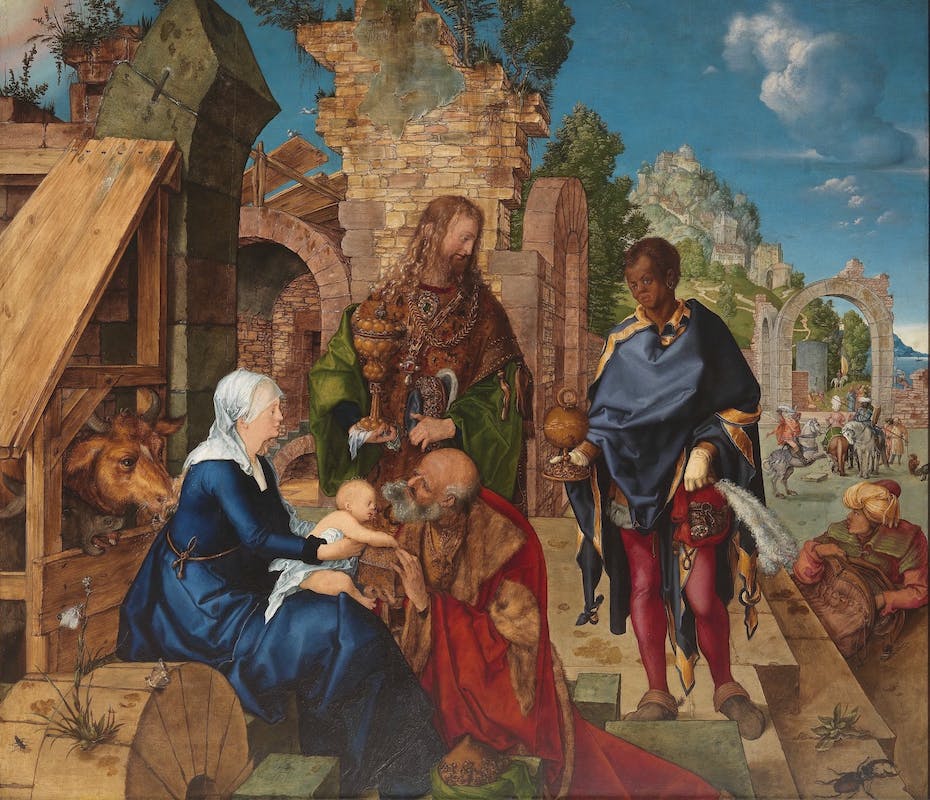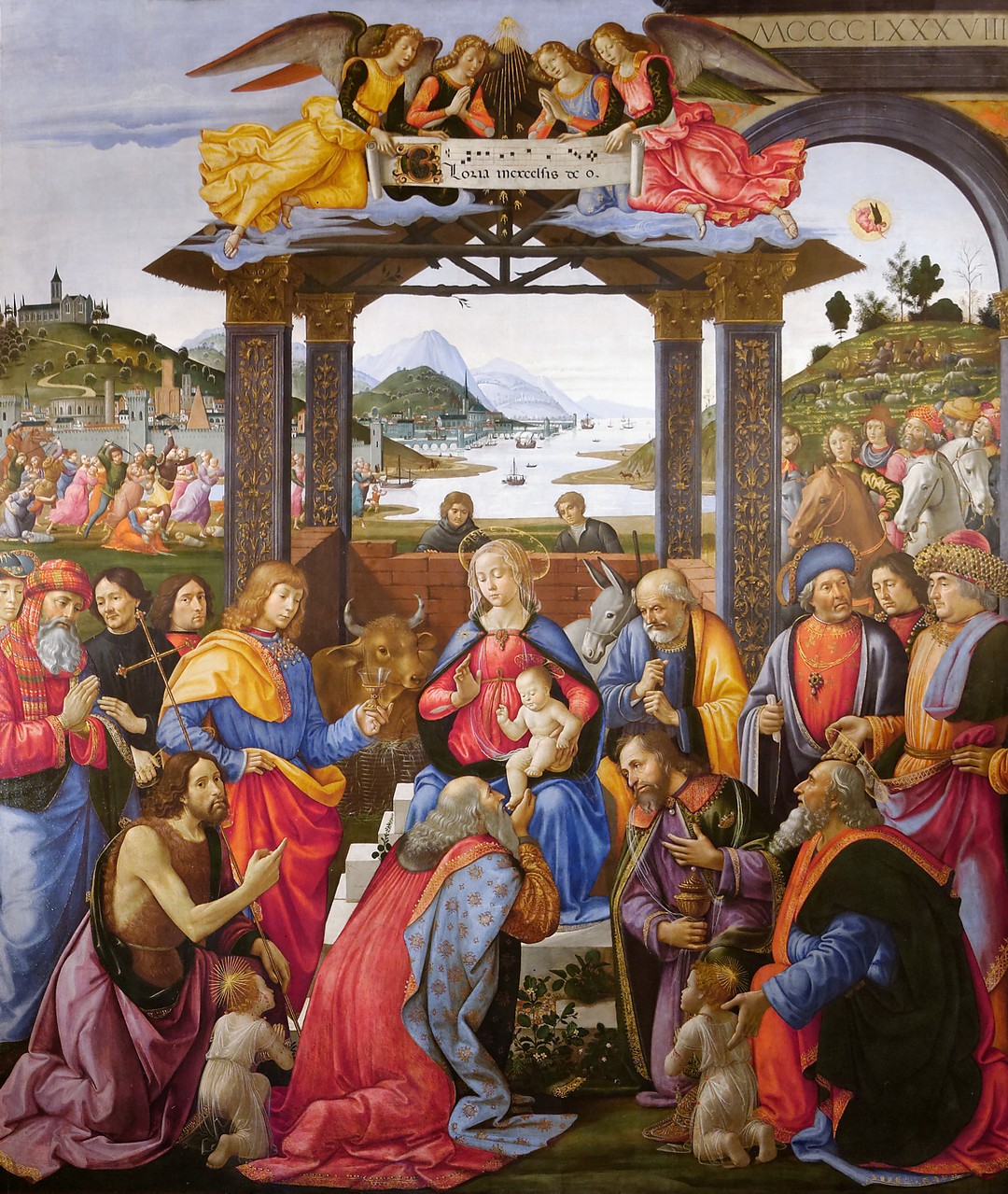Back to: Renaissance Art and the Christmas Story
Albrecht Dürer -” Adoration of the Magi” (1504)

The three Wise Men, Kings or Magi, have brought gifts of gold, incense, and myrrh to offer to Jesus.
The Madonna is clad in azure clothes and cape, a white veil covering her head. She is holding out the infant, who is wrapped in her white veil, to the eldest king. He is offering the infant a gold casket with the image of Saint George, which the infant has already taken with his right hand. This is the only action that unfolds in the principal scene, except for the Oriental servant’s gesture of putting his hand in his bag. All the other characters are motionless; immersed in thought, they look straight ahead or sideways, creating the effect of a staged spectacle set with immobile characters.
The king shown in profile is thought to be based on Dürer himself, a man with long, blond curls recalling the self-portrait at the Prado. The whole scene is described in elegant detail and search for particulars: fabrics, brocades, crowns and goblets (made by goldsmiths in Nuremberg), rubies, pearls, the Virgin’s veil, feathers, animals, and plants, all according to Flemish tastes from the other side of the Alps.
The color selection is also worth mentioning: in the foreground, the red, green and blue; in the background, the blue of sky and sea with a palette that becomes lighter and brighter as it opens out onto a fairy tale landscape, with knights and a village in the distance. The iconographic choice is focused on the main characters: the Virgin showing the Christ Child to the three Wise Men, who have brought gifts of gold, incense, and myrrh.
In the European image of the Adoration of the Magi, it is a common convention to represent the third king as a black figure. In Dürer’s composition, this figure dominates the right portion of the painting, counterbalancing the cluster of the other four figures on the left (organised in a pyramid structure) due to his difference.
Dürer was devoted to the study of animals and plants and reproduced them. In the foreground, to the right, there is a flying deer, which here symbolizes Christ; the plantain which look similar to bananas are seen directly behind, whose healing properties were once much appreciated, recalls the spilled blood of Christ. In the foreground, to the left, on the millstone beside the carnation, a small collection of insects surrounded by a few butterflies, the ancient symbol of the soul, which here may be a symbol of the resurrection.
Domenico di Ghirlandaio – Adoration of the King (1481-82)

The Madonna occupies a central position inside a pyramidal composition. The Child is held up to be seen by the Magi and the other spectators. Two Magi are positioned at the base of the composition, one kisses the child’s foot, and another kneels with his hand on his chest. A third Magus stands on the left, wearing a yellow and red cloak, gifting a richly decorated chalice.
According to the tradition, they represent three different ages of man: youth, maturity and old age. At their sides, crouched, are St. John the Baptist, who looks at the viewer and (in keeping with the contemporary theme) points to the Child; and St. John the Evangelist, who is presenting a wounded child. Another child, in a hint to the orphans cared by the Hospital, is at the opposite end. They are also referred to by the scene of the Massacre of the Innocents represented in the left background.[4]
The traditional ox and donkey surround the Virgin, together with St. Joseph. The hut includes an unfinished brick wall, a symbol of the decline of paganism, to be replaced by Christianity. The ceiling is supported by four columns decorated with candelabra and gilt Corinthian capitals. Above it, four angels hold a cartouche with a tetragram with the notes and the first words of the Gloria.[5]
Ghirlandaio painted in the left foreground a series of characters, among which are the donor (dressing in black), and the artist himself, who looks towards the viewer. On the right, in the Magi procession, are three richly donned men, which have been identified as major members of the Arte della Seta (Guild of the Silk Workers), the main financial backer of the Hospital. Above them, the procession continues in the far background, passing under an arch (with the date, MCCCCLXXXVIII, or 1488) another possible symbol of the fall of the transition between paganism and Christianity. The five horses were painted starting from only two cartoons, adding some small variants in the heads. The same sector of the background depicts the annunciation to the shepherds by a flying angel. Finally, painted above a lake landscape with ships among hills and mountains, a layman and a clerk observe the scene: they symbolize the main institutions backing the orphanage.
The city in the left background is a symbolic representation of Rome. edifices include the Colosseum.
